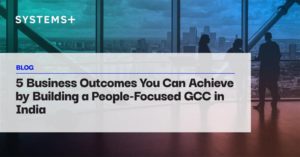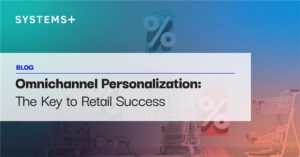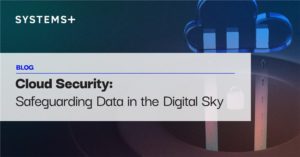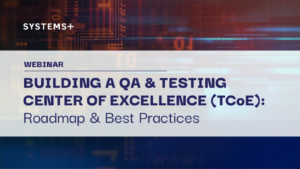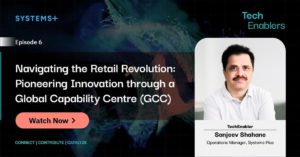Amay
“Hey everyone, welcome to Enabling Digital with Systems Plus. Today, we have Rob Krugman from Broadridge joining us as a guest. Welcome, Rob.”
Rob
“Thanks for having me. Glad to be here.”
Amay
“Alright. So, Rob, if you could just start with telling us what is Broadridge, what you guys do, and then what is your role as the Chief Digital Officer?”
Rob
“Yeah, sure. So Broadridge is a global fintech. Our primary businesses are in the financial services industry and really two major parts of our business. About a third of our business is our global technology outsourcing business, where we work with capital markets and wealth management firms to provide infrastructure that they can run their businesses on top of it. And, on any given day, there's about $10 billion in assets flowing through our systems and clearing through our systems.
In the US, for example, about a third of all US equities clear on our platform. So, very large platforms that are used by a lot of the names that you're familiar with, where the underlying plumbing, if you will, lies in the software that they use. The other, essentially two thirds of our business to three quarters of our business is our communications business, where we really play a role where we sit between the major players in the ecosystem, the issuers of different types of assets, broker dealers, and investors to make sure that appropriate information is flowing to the investors about the assets they hold. And that ranges from regulatory- required communications like proxies and prospectus documents about assets and holdings to trade confirms and statements to really any type of communication that needs to flow through those two different areas. And then that business is actually expanded beyond the financial services and the wealth space to include all different types of communications in the insurance sector and utility sector and the energy sector.
Just to give an example, in the US and Canada, we're the largest first-class mailer in both of those countries. But while we distribute a lot of physical material and a lot of digital material, we're really a big data company that's basically capturing all the information and making sure that information is available. To simplify it, my bank sends me a statement on a monthly basis. You guys are probably powering a lot of that communication. Behind the scenes, we may be, we're probably collecting all the information, we're composing those communications and then distributing them either digitally or physically.”
Amay
“Awesome. Exactly. Yeah.”
Rob
“It could also be a bill from your credit card company or from a statement from your bank from all different participants. So my phone bill potentially, utility bills, all those type of things also, as you said, we’ve expanded. It's an interesting network. We basically support communications for upwards of 5000 different companies that different consumers use for a variety of different services.”
Amay
“Wow. OK. And how did you land up at Broadridge, how has your career been, and how have you now become the Chief Digital Officer?”
Rob
“Yeah, sure. My career started as a developer. I went to school for computer science. My first job after college was actually on funds transfer systems where I was just a C programmer building on top of the network to facilitate interbank funds transfers. In the mid-90s, as the Internet started to become a thing, me and several colleagues got together and we formed a startup that was really a dot-com consulting firm. It was, as we looked at the banks and the different organizations we were working with, how do we actually begin the process of helping those firms to go online and start to move their business to this new thing called the Internet? And that acquisition, actually, there was a bunch of other acquisitions that occurred through that process.
If you're familiar with the digital agency called Razorfish, that's one of the firms that's coming out of that process. And so, I did that for probably eight or nine years. I then did two different data startups, one was a company called Edgar Online, where I was the Chief Product Officer. We essentially created data products off the Edgar system in the US, which is the SEC system for regulatory reporting. And we created all different types of data products and services that people could use.
I then did a small stint at a company called themarkets.com, which was owned by the bulls bracket, the largest sell-side organizations in the world as a way to distribute their research, and I ran data products for them. And then, I had known Broadridge for a while, we had been talking for a little bit, and I joined Broadridge on a digital strategy role of how do you take this very successful business, largely in the physical space, and begin the transition of that business to the digital space. I've been here for about 13 years. My first eight or nine years was really focused on that kind of communications business and then I moved into this role of Chief Digital Officer thinking about how do we digital transform the organization. Today, my job is really around two primary areas. One is around digital strategy and transformation. And then the other area where I more and more spend a lot of my time is around innovation. How do we take advantage of technology to create new products and services to solve for our clients’ needs? We've established an innovation lab to facilitate that. I was recently actually in India because part of the team is in India and we were visiting the team there as we started to experiment and try out new types of solutions to see what we can do.”
Amay
“Awesome. so it's interesting, right? You said you were Chief Product Officer for a startup. I've also been in the product space and I feel that's a very different type of lens that you come in if you're a product guy. How did you take that sort of thinking from, ‘product is the intersection of design, business, technology’, how did you take that? You've spoken about design thinking as well a lot in the past. How did you take that to Broadridge as part of that transformation? And what is the methodology that you play today?”
Rob
“I think one of the challenges a lot of organizations have, in particular successful organizations, is you get very comfortable in the solutions that you're generating. You come up with new ideas to say, ‘hey, if we did this, we could increase revenue by X or if we did this, we decrease cost by Y’. And sometimes what gets missed from that conversation is really the voice of the customer. Right. we're in a B2B space, so that actual conversation makes it even more challenging because while our customers are other businesses, their customers are individuals. SO, one of the things that we've really tried to talk about across the organization and implement in as many places as we can, is the need to truly understand the needs of our clients, customers.
From a design thinking perspective, these are not the people that we're selling to. But, if you think about the brokerage industry, if we can create solutions that satisfy the needs of the end investor, there's a pretty strong likelihood that it’s also going to satisfy the needs of the advisor, which is going to satisfy the needs of the brokerage firm, which will then satisfy the needs of Broadridge because we're creating solutions to basically facilitate that. If you think about the different areas where we have large footprints, one is in this communication space. A lot of the communications we distribute are communications that need to be sent for a variety of reasons. Some of them are regulatory driven, some of them are driven by a need to get paid, like a bill. So the problem is that organizations often think of it as a checkbox. Let's send out the bill. Let's send out the statement. Let's send out this disclosure material. If you flip your mindset and use design thinking there, what you quickly begin to realize is, what if we actually did this a little bit differently? What if we actually spoke to those end investors and understood what they care about and transformed these communications to not only satisfy the regulations but satisfy the regulations in a way that we're educating the investor about what's important and what this means to them. Because when you do that, communications don't simply become something that you need to do, they become something that you want to do.
The people that are using the systems are operational people and there are advisors that are using some of those systems. Eventually they probably touch investors as well. How do we better understand the actual roles that each of those individuals play and then use that as a driver to make changes to our platforms? We're not just satisfying the needs of today, but we're doing it in a way that makes it easier for our clients and our clients' clients to be able to interact and use those tools.”
Amay
“What you described is very typical. If you look at startups today from the Bay Area, the product manager at every new startup has a product manager, a super important role, where their job is to interview customers. Is that something that you have in Broadridge today? Was it there before? How is that role played? What does that team look like?”
Rob
“There’s two different roles. I'll talk about our product and I'll talk about my organization because they're a little bit different. Like many organizations that have been around for a while, there's this migration to a product-centric model. Historically, that's not the way most organizations worked. It was much more of a project-centric model and running a particular business. What we've done is we've implemented a product focus where the idea is that every single product that we have in the organization does have a product manager. And then to begin to provide the underlying tools that are required for that product manager to be able to do things like design thinking-based methodology.
So we make sure we're actually doing research, make sure we're actively speaking to customers to understand what their needs are. Speaking to customers, but then using that as a research to better understand what their real needs are, and to build that and then build out roadmaps and actually implement that in the long term to think about how we transform our platforms, not just through technology. But I think increasingly over the last 15 or 20 years, the way you really transform products and platforms is through experience.
How do you deliver experience that makes it really easy to use and to work and to leverage capabilities? Even more recently, that's taken the form of AI. How do we leverage AI to provide efficiencies and different tools to help that process? In my organization, it's a little bit different because we're not a product organization. We're an innovation organization. So we have the idea of an innovation manager. And the innovation manager's job is to basically go out and explore and do research and uncover, which is what you want to do in both roles, but in innovation, I would argue it may even be more important, is you want to validate concepts as quickly as possible because when you're trying to create something new, you want to fail as quickly. As everybody says ‘fail fast’. Failing fast is really important because what fail fast means is that you can point the limited resources that everyone has someplace else because you've proven this is not worth our time. So instead of starting with a feature or a function or requirement, you start with a question. What if we were able to do this? Well, how do we validate that that actually makes sense to do as quickly as possible? And that's where you kind of move. It’s a little bit of a different role, but there's obviously a lot of similarities.”
Amay
“Is your team as innovation managers, working alongside the product team or feeding information to the product teams that they can factor in into their roadmap? Or how does that relationship work between them?”
Rob
“I think that innovation needs to be anywhere and everywhere in an organization. Product teams, for the most part in organizations are responsible for what I would refer to as sustainable innovation. How do we think about the roadmap of our platform and the threats that are out there from new technology or from new players? And how do we continue to innovate that platform to make it to ensure continued relevance in the marketplace? That's the role of a product manager. The role of an innovation team is really disruptive innovation. As we start to see things happen, is there an opportunity to create a solution in that space? And that space may be an extension of something that we already do. It may be a rethinking of something that we already do, or it may be something brand new that gives us an opportunity to create something different. I think the coordination there is that, you don't want to as an innovation team, to get in the way of the product organization from doing what they're actually accomplishing.
But when questions do arise from the product organization that they may not have the time or the effort to be able to explore, that's where the innovation team can become very helpful in basically taking those things up and uncovering, what should we be doing with this particular area?”
Amay
“Right. OK. So, where do the ideas come from? How are these guys figuring out what questions to even ask?”
Rob
“In a mature innovation practice, questions come from a number of different places. One is the businesses themselves. Businesses come up with questions or maybe, they're in conversations with clients that open up new questions- that's kind of one bucket. The second bucket is the clients go out and actually proactively speaking to the clients in the sales organization to understand what's the buzz in the street, what's actually happening, what's going on. The third is the innovation team itself, like what's this new technology we're hearing about? Is this something that we could leverage? Is it worthwhile or is it worth our time? An example of that would be, one of our teams is currently spending a lot of time thinking about digital assets. I always joke that the demise of crypto has been greatly exaggerated over the last year. It's up almost 130, 140 percent. What has been missing is a regulatory framework for disclosure.
So, as we started to enter this space, we said, based upon what we do in other markets, is there something that we can do to help this market mature and provide insight? And that's been one area of focus that we've been thinking a lot about.”
Amay
“I do want to get more into crypto and we'll touch on that towards the end. But what I'm curious to know is, we're talking about innovation and we always say in innovation, we have to think long term. Jeff Bezos famously says he's always thinking long term. That being said, there's short term needs that the company has. Do you find that your innovation team plays a role in those short term needs or is it only really looking at long term innovation?”
Rob
“I think it's a hard question to answer, because what you don't want to do is, you don't want to get in the way of the product teams doing what they're supposed to be doing. But there is obviously an opportunity for tactical innovation. ‘Hey, we see this problem over here. It's actually pretty small. Let's implement that and get that done really quickly and see if it actually works.’ And it's a problem that we can solve because you don't want it just to simply be about three to five year out-there problems. Though it really depends upon the organization. To your point, Amazon or Google may have massive amount of resources focused on three to five, five to 10 year-out things, while other organizations may basically say, ‘OK, the vast majority of our resources are going to be focused on this one to three year horizon. And we'll have a little bit focused on three to five’, which is, I think, where most organizations play.”
Amay
“Got it. Let's say your innovation team does a lot of hypotheses testing. Of course, some things, as you said, will fail, and rightly so. But some things will work. How do you then take that back to the organization and sell it? Because another thing you've always spoken about is the need for storytelling and actually using that to sell some of these initiatives if they're actually a good idea.”
Rob
“Yeah, let's be honest, it could be hard sometimes. I think that there is natural tension in any organization where you have people who are responsible for running businesses as they get very large, that's their primary focus, and you know what? That should be their primary focus. When this guy over here that kind of looks like Willy Wonka is coming and telling you that you should do something different, there can be some tension in it. As we think about it, we’ve created our approach towards innovation, we really thought that there's four different answers to an innovation activity.
The first answer is ‘this is a really bad idea and we should not do this’. And hopefully that's the answer you get to as quickly as possible, because the longer it takes to get to that answer, the more money you spend which means you couldn't be doing other things. The second one is ‘it's a good idea, what are we going to do with it?’ So, this naturally fits in this product organization, let's incubate it, get it to a certain place, maybe pilot it and then hand it off to that product organization. The next bucket is ‘this is a really good idea and actually requires a new business unit. We don't have a business that actually can facilitate this.’ We should think about creating a new business unit or maybe a new section of an existing business unit as you actually grow and implement that. There's lots of examples, if you think across fintech, where people have done that. I look at Fidelity. Fidelity created an entire digital organization based upon stuff coming out of their lab. The next potential answer is ‘this is a really good idea. But it doesn't fit what we do.’ That can actually take different forms. You could say, OK, we should spin this off as a new organization. Or number two, maybe it actually becomes a consortium play where you actually spin it off and it becomes a consortium that's owned by different participants in the ecosystem. We haven't done that yet, but we can definitely see areas where that potentially could be an option. As we build these things out, you learn along the way and then you learn what's viable for Broadridge to be able to facilitate and then what's not. Just because something doesn't fit within our four walls doesn't mean it's a bad idea. It just means we have to think about another way of executing it if we decide to do that.”
Amay
“OK. I would like to understand how big your team is. If I'm an organization, a fairly large one, and I want to set up an innovation team, I don't have one today. Where do I even start? How much budget should I even look at allocating?”
Rob
“I think you have to start where the question becomes how many experiments do you want to be able to do at once? I think in an ideal scenario, you're capable of doing two things at a time. But that doesn't mean they start at the same time. So, if you think about what you need from an innovation perspective, you need a leader. You need research. Research is, I would argue, the most important piece because research enables us to validate things without spending a lot of money quickly. You also need that research capability. You typically need a design capability because design is how you make that research come to life in a way that doesn't require development. So, a five or six person innovation team can work very well.
If you do it right, you can space it. As the research function and some of the design function upfront starts becoming available, you can start the next project.”
Amay
“But you have innovation teams that are actually kind of responsible for these activities and making sure they're functioning, and like you said, how many experiments do you really want to attack at any given time. So, how big is your team approximately today?”
Rob
“Right now, we have about 18 people that are working from an innovation perspective. But what's interesting is, if you look at innovation, BCG does a report on the most innovative companies in the world every year. And they phrase the concept of what actually is an innovation-ready organization and they show failure. This is sometimes a very uncomfortable thing for established business leaders to think about. Typically, in innovation-ready companies, the failure rate is well over 90% which can hurt some people's heads depending upon like if you come from a much more tactical accounting operations background, you're like, we're going to fail 90% of the time. Yeah, we are, but we're going to do it as quickly as possible, so we actually don't spend any more money. We just simply fail and we move on to what's next. And I think beginning to build up that cadence becomes really important.”
Amay
“Yeah, it's funny, right? I actually have a colleague who works at Google X, which is sort of Google's innovation lab. And for them, even success is not what we would think of success. If it's a 5 or $10 million business for them, that's a fail. And then, they go for moonshots. Most of the businesses would have been good businesses, but they're not those moonshot businesses. It doesn't fit into their larger agenda and they're like, all right, scrap it off. And then, of course, you get way more of the world and self-driving cars and all those cool things.”
Rob
“First of all, I think it'd probably be a pretty cool place to go visit Google X. I have visions in my head of walking in there and being like, wow. But I do think that setting those goals is such an important component of an innovation agenda, right? What are you actually trying to achieve? Are you trying to do research? Because some innovation activities are really around doing research and creating strategies. But I think the better ones are around actually incubating and creating new ideas.
What actually constitutes a good idea? To your point, for Google, it may be ‘we're not going to actually move forward to any idea that the market opportunity is less than a billion dollars’. But for another company, it may be a million-dollar barrier or a 50 million dollar barrier. For other organizations, it may be around protection. Like, how do we protect this business? Well, we're going to do innovation around new ways to do what we already do to provide more efficiency and create different approaches. So, we have optionality in the way that we go to market and the way that we deliver. And like you said, it's very key to understand where you want to be as a business and how those innovation ideas fit into your business. Does it make sense as a separate business unit or potentially as a consortium? Or you just axe it because it just doesn't make sense from a strategic point of view? And that's a hard one.
A lot of companies have a problem with failure, right? Even when you prove something out and say, this is real, but this isn't for us. We should just kill this. I've done work with some very large technology organizations in the world in the past where they really have gone down very far where they probably have spent millions of dollars on an idea. And they said, you know what? This doesn't align with our strategy. We're going to kill it. It's tough to take that call.”
Amay
“But I think that separates the good leaders from the great ones, potentially.”
Rob
“Well said.”
Amay
“Yeah, so you said your team is 18 people, but Broadridge is how big?”
Rob
“We are about 15,000 resources globally. So we're small.”
Amay
“Yeah, exactly. So comparatively, you've got an innovation team of 18 people. You've got a 15,000-person company spread across the globe. How are you managing innovation for such a large organization globally with such a small team?”
Rob
“I think it's a portfolio approach, meeting with different businesses and understanding what they're working on. Now, the reality is, we're not doing all the innovation for the organization. We have Center Of Excellences for different things. We have an AI center of excellence where they're focusing on AI and they've actually had some really nice product announcements recently. We have a digital center of excellence, which is really a digital communication center of excellence. We have a data center of excellence that's working on different activities. So, we have other resources that are working on innovative solutions. Those innovative solutions just happen to be much more tied to the businesses that we actually play in versus my team, which is looking at the disruptive innovation aspects of things.
But the key is to understand what's going on, to have meetings to be transparent about the activities that are happening and who's leading those activities. We're a relatively new organization in Broadridge. We've been stood up for a little over a year and we've started to make some real progress. So, the hope is, success begets success. And you actually start creating real platforms that have a huge amount of value as you move forward.
Another question, which I think every company, especially larger ones, absolutely struggle with is- you've got such a large organization, lots of ideas. Your team is still pretty lean. How do you prioritize? What am I going to work on now versus what am I not going to work on? It's a real challenge because then it comes down to, you don't want to hurt people's feelings, right? That's probably my nice way of saying that, but you want to make sure that the business units buy into the ideas of what you're working on. Part of it is making sure that you're spreading the ability to work in different areas so that everyone feels like they have ownership and they're participating in this process. So that becomes really important. I think number two is impact; can you do a little bit of research up front on each of the ideas that have been submitted to truly understand the impact that they can make and the likelihood of us succeeding? It doesn't pass the sniff test- the goal is not to, you can't go to every business and say, give me 15 ideas. It's got to be like one or two ideas that you think are interesting and then be able to explain why one idea was selected over the other idea. That transparency becomes really important as you start to think about where you're going to focus and then what resources do we have. That's a really interesting idea. I don't think we can actually do that with the resources we have. We would need to pull in more resources. Is there an opportunity to increase budget to do that or not? If there's not, we may have to skip that one right now.”
Amay
“Right. So, is this process something you do annually, every quarter? How often?”
Rob
“I'm going to say it's an evolving process. We're kind of learning as we go through. We do a bit of roadshows where we meet with different people in the organization to understand what they're trying to solve for. What we try to do is we try to identify ideas that are adjacent to the business, but not integrated to the business. Because when they're specifically integrated to the business, we want to be able to innovate quickly. If you think about what that means is, if we need to innovate on top of proprietary data or PII information, that makes things really complicated. So, the only way we would do that is can we create synthetic data that matches that information that's made up so we can actually see if we can incubate something. So that's part of it. But it's really about going out and making sure you have strong conversations with people, with the product leads and the business leads in the business to understand what they're thinking about. It's also obviously about being well-read and understand what's going on in the market. What are some of the trends that we're seeing or a lot of the third parties that are analyzing our market space are seeing, and how do we begin to investigate whether there's opportunities for Broadridge to participate in those?”
Amay
“Right, you spoke about roadshows. One visit that you mentioned- you just went to India and came back. So, what's going on in India? I know Broadridge has a presence there. Can you just tell us more about that?”
Rob
“Yeah, we have resources in Hyderabad, in Bangalore, and we have a smaller facility in Mumbai. We have over 6,000 people between those three different places. It's a combination of development resources and back-office operations and a lot of the other things that you would expect. From our perspective, we have created a development organization to support what it is we do from an innovation perspective, and that's why we're visiting. But then on top of that, I think it's safe to say that we're fairly fascinated about the Indian market and what's happening from a financial services perspective, and so we've started to establish relationships. We have a relationship with T-Hub in Hyderabad. We have a relationship with ISV and we're exploring other relationships where we can identify startups very early on that potentially we could partner with, we could provide distribution, or there are technologies that we could use to solve problems that we're trying to achieve. I think that's pretty interesting. That's kind of like observation number one. Observation number two is the payments infrastructure that's been implemented in India is, I would suggest, it's the best in the world. There's nowhere else where there's a system that's as efficient in real time as what's going on. The ability to walk to any vendor and just pull out your phone and send them money through a QR code is fascinating. As kind of an innovator, tech geek, futurist, I get really excited about the features and functions that you can put on top of that. So I think as we learn, one of the big questions becomes, when is the right time and the opportunity for the rest of the world to start introducing products specifically for the Indian market, right? Which is pretty awesome because it's not an insignificant market. I come back and I explain to people that you guys have more people in the middle and upper class than the United States has people! And it's growing every single year and every single day. I joked with my team in Hyderabad that I was there in August and between August and January, I feel like the city has grown by 20%. How did the buildings get finished so quickly? So, I think that India not only has a huge opportunity ahead, but I think that the world is going to start to take notice of actually creating products specifically for the Indian marketplace because the financial rails, the banking rails that are in place are arguably the most technology-advanced that exists anywhere else in the world.”
Amay
“I think that what you were referring to in India was the UPI, right? The Universal Payment Interface. Just for example, today I had to buy something off a vending machine and there was a QR code. So you just take out your phone, scan the QR code and off you go, right? No credit card and payment processor and all of that stuff. It is honestly pretty amazing, actually very convenient. What advice would you have for any organization maybe looking to set something up in India? Of course, most people are looking at it more from a cost center also maybe as innovation center, but what you mentioned was also more as a profit center because India is such an emerging market. What advice would you give to organizations looking to maybe enter the Indian market?”
Rob
“I think the first step is to go and visit, because for better or worse, there's preconceived notions that folks have about India. I didn't know and I came home mesmerized. The culture, the food, the smells, the taste, everything, but more importantly, the amount of innovation that was happening there! I've had opportunities in the past where I've worked in the Valley, in California, and seen the really true innovation that occurs there. I've done a lot of work out of Tel Aviv which I would argue is probably the second largest innovation hub probably in the world. But coming to India, and in particular T-Hub, really started to blow me away and I understood the vast size of the startup ecosystem that exists. More importantly, the strong desire of the federal government and the state governments to support that ecosystem and drive value there to make that happen. Those things are really important foundational elements. The last piece is that, unlike other startup incubation locations and I'll use Israel as an example, or you could, where it's a smaller country, or you could think about Australia as a place for incubation or Singapore as a place for incubation, or even Canada and the US as a place for incubation, those markets are very small. So, typically what happens is, a startup is trying to get distribution to the European markets and the US markets immediately when they start. The difference in India is that as a startup and as an innovator, you can start creating solutions for the Indian market. Because it's somewhat emerging, the economy continues to grow in different ways, it may not need to hit the same level of maturity that a solution that you would launch in the US market, for example, would happen. In the US market, it has to work 24*7, 365 days, always has to work, always has to be on. But that's a goal that if you're trying to create something new as a startup or even as an innovation team with an organization, if you're trying to achieve that, that's unachievable. And it's going to actually lead towards failure. But if I look at India, ‘hey, we can launch something and we can set parameters around what this is going to do to provide improvements to what's currently available, test out these concepts to do it, and then take it from there and bring it to other places because you've been able to validate and actually start to mature it.’ So I think there is huge opportunity and I think the only way you can see it is to go and visit and have a bunch of meetings.”
Amay
“Just quickly on the non-tech side, so you have 6,000 people. I know a large part of them are technical but is there also sort of a large non-tech component that is supporting the Broadridge business?”
Rob
“We have strategy people and operations people. We have designers and business builders. We have quite a wide range of people that come from different resources, different skill sets, just like we have in other areas of the world. I sit in New York, New York is where our headquarters are. I think between our three facilities here, we have somewhere in the neighbourhood of about 2,500 to 3,000 people. A lot of sales obviously included as well, a lot of people in development and design resources. India is the only other location where we have that level of scale where we have a similar mix of people and focus.”
Amay
“Awesome. I really want to wrap this up with going back to something we spoke about earlier, which was blockchain, AI. I know you met with, I think, ISB, and you had a conversation around blockchain over there. What are your thoughts with what's happening around those two areas?”
Rob
“You know, I often joke when people ask me this question, because I think 2023 was AI's coming out party. All of a sudden, everything and everywhere was AI, AI, AI. I was at a conference recently where someone suggested that today, AI is as worst as it will ever be, and tomorrow it's going to be better, and the next day it's going to be better, and the next day, and I think that's fairly accurate.
I look at blockchain, I think that blockchain fairly or unfairly got caught up in a lot of the crypto currency-related hot logs and buzz. But what are we seeing happen with blockchain? Well, we're seeing, starting in the banking industry, massive infrastructure migration where very large banks are basically replacing their clearing and settlement systems for banking with blockchain or DLT based technology. So that's usually step one. Usually what we see in markets is that in financial services, what starts in banking takes three to five years and makes it to the capital markets and brokerage space, and three to five years later, it makes it to the insurance space. So you can start to see this migration where clearing and settlement is not just going to be real time, but it's going to be massively more efficient than where it is today. Then you think about AI and tying in AI decision-making to that process. It's pretty fascinating because I actually think that that's really an interesting combination of blockchain plus AI to basically run back and middle office for large financial services firms and probably healthcare industries and other industries as well.”
Amay
“Awesome. All right, well, that's all I had, Rob. Thank you for joining us and really appreciated the conversation.”
Rob
“Thanks for having me, enjoyed the conversation and really appreciate it.”
Amay
“If people want to get in touch with you, is there a preferred channel for that?”
Rob
“Sure, you can reach out to me, Robert Krugman on LinkedIn. You can send me a note at rob.krugman@broadbridge.com. Happy to get in touch with people and communicate in all different ways.”
Amay
“Awesome, thanks a lot, Rob.”


